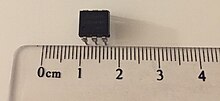
Back مرحل الحالة الصلبة Arabic Relé d'estat sòlid Catalan Solid state relé Czech Relais#Halbleiterrelais German Relé de estado sólido Spanish Pooljuhtrelee Estonian رله حالت جامد Persian Puolijohderele Finnish Contacteur statique French ठोस अवस्था रिले Hindi
This article relies largely or entirely on a single source. (February 2015) |



A solid state relay (SSR) is an electronic switching device that switches on or off when an external voltage (AC or DC) is applied across its control terminals. They serve the same function as an electromechanical relay, but solid-state electronics contain no moving parts and have a longer operational lifetime. Solid state relays were invented in 1971 by the Crydom Controls division of International Rectifiers.[non-primary source needed][1]
SSRs consist of a sensor which responds to an appropriate input (control signal), an electronic switching device which switches power to the load circuitry, and a coupling mechanism to enable the control signal to activate this switch without mechanical parts. They may be designed to switch either AC or DC loads. Packaged SSRs use power semiconductor devices such as thyristors and transistors, to switch currents up to around a hundred amperes. SSRs have fast switching speeds compared with electromechanical relays, and have no physical contacts to wear out. SSRs are unable to withstand a large momentary overload the way an electromechanical relay can, and have a higher "on" resistance.
- ^ "Solid State Relays". Sensata Technologies. Retrieved 2023-02-01.
© MMXXIII Rich X Search. We shall prevail. All rights reserved. Rich X Search